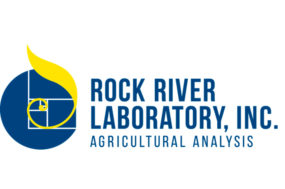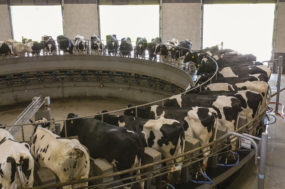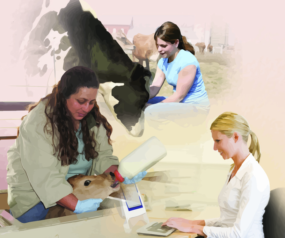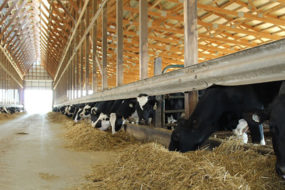Two Wisconsin farm families are grieving the loss of two young men, one a 29-year-old farmer from Amherst, the other a 16-year-old boy from Owen.
Mike Biadasz, 29, of Amherst, Wisconsin, allegedly died from “acute exposure to hydrogen sulfide gas,” on August 15, according to a report by WSAU Wisconsin News. News reports indicated that he was agitating the farm’s outdoor manure pit in preparation for spreading it on the fields when he was allegedly overcome by the toxic fumes released by the pit and died.
According to the news report, the coroner said that the weather conditions were exactly right to trap the gases close to the surface instead of allowing them to blow away on the wind. According to the Stevens Point Journal, the toxic fumes from the manure pit also killed 16 nearby cattle.
Biadasz hasn’t been the only victim this year. According to a report by the Wisconsin Ag Connection, 16-year-old Jonas Hoover of Owen, Wisconsin, was found inside an empty manure tanker on September 14. Authorities are uncertain whether he crawled inside the tanker to make repairs, or simply looked in before being overcome by the fumes. According to the news report, Hoover died after arriving at the hospital.
Farm fatalities from toxic manure fumes occur every year. Some appear in the news, some do not, but each one is a heart-wrenching loss for the family and friends the victims leave behind. There is no hard and fast statistic for how many people die each year from hydrogen sulfide poisoning, but the risk of exposure to toxic gases while agitating, hauling and spreading manure is real and needs to be attended to.
Hydrogen sulfide, one of the toxic gases released by decomposing manure, is the main culprit of most toxic gas exposure accidents that occur each year, according to experts. Hydrogen sulfide is not to be confused with methane gas. By chemical composition, methane gas is lighter than air and easily dispersed into the atmosphere once it has been released from the storage pit. Hydrogen sulfide is heavier than air and is more likely to linger on the surface.
According to Davis Hill, agricultural safety and health expert from Pennsylvania State University, methane isn’t a real problem in situations where manure is stored outside, but it can be dangerous in enclosed spaces like a storage channel under a barn where there is no airflow.
“During storage, the solids of the manure will settle to the bottom and the liquids will rise to the top,” Hill says. “Picture 10 or 12 feet deep of this material. Spread throughout that 12 feet are different bubbles of hydrogen sulfide just sitting there. Farmers need to stir that stuff up to mix the solids in with the liquids, so when they do that, if there were a crust on the top, it keeps all those bubbles inside until they stir it up.”
What experts refer to as a plume of hydrogen sulfide gas is released immediately when farmers begin agitating the pit. “Of course that gas all has to go somewhere, so it’s going to move around on top of that storage tank, and if it’s a hot, humid day, which is often the times when we see this problem, that gas will just spill over the edge and hang in the low areas around the storage structure. You can have significant levels of this hydrogen sulfide gas just hanging around,” Hill adds.
Obviously all farmers who agitate their manure pit do not die from exposure to hydrogen sulfide gas, but the risk of toxic gas needs to be taken seriously. “We try to inform farmers the potential is there for hydrogen sulfide gas to be present anytime they stir manure, and remind them that just because their manure is stored outside in an open pond or in a tank outside doesn’t mean there couldn’t be a serious negative consequence to that,” Hill says.
Poisoning from toxic gases happens more often in late summer and early fall. The high temperatures and humidity increase bacterial activity, increasing the amount of gas in the manure. “If it’s hot, if it’s humid, realize that you could have more of a gas problem than normal, and you should at least be alert to that.”
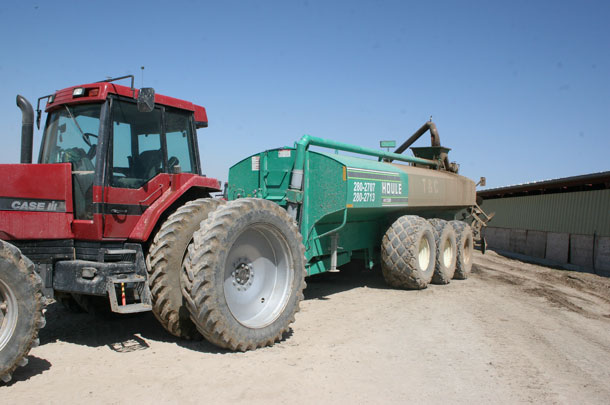 There are a few different ways farmers can take precautions with their herd. First, they can pay close attention to feed. The herd diet is always under close scrutiny, but attention to the kinds of ingredients in herd feed could help cut down on the amount of sulfur in the manure.
There are a few different ways farmers can take precautions with their herd. First, they can pay close attention to feed. The herd diet is always under close scrutiny, but attention to the kinds of ingredients in herd feed could help cut down on the amount of sulfur in the manure.
“Some of the products that we’re starting to feed our cattle also have high sulfur content,” Hill says. “One of those is dry distillers grains. It’s a great byproduct for cattle, but it has a high sulfur content as well, so it has been suggested, at least, that some of these products we are feeding our cattle could also create some high sulfur content manure.”
Another product known to increase the sulfur content of manure is gypsum. Pennsylvania State came out with research in 2012 showing dairies that used gypsum bedding had a higher amount of sulfur in their manure.
“This product is high in sulfur content and if you’re going to use it for bedding it is inevitably going to end up in the manure storage, so this product creates even more sulfates in the manure suspension,” Hill says. “That product has been directly linked to causing high hydrogen sulfide content as a toxic gas. We know if farmers are using gypsum, we can go out and tell them to be really careful about extra hydrogen sulfide.”
Click here to read a related article with more information on the safefy risks of gypsum bedding.
Hydrogen sulfide gas is a natural part of manure decomposition, so farmers need to be prepared to deal with that issue before agitating their manure to decrease the risk of injury or death from the fumes. Cheryl Skjolaas, interim director of the University of Wisconsin – Madison Center for Ag Safety and Health, says it’s a matter of getting into the habit of practicing farm safety and advises developing a set procedure so when those situations occur, farmers know what to do and can do it safely.
Skjolaas says being aware of your situation and surroundings can help safety-wise as well. Knowing what buildings or trees block the wind, knowing where to position the agitator to assist with airflow and paying attention to the weather can help disburse the hydrogen sulfide.
Using a single or multi-gas detector is one of the best ways to stay safe while working in proximity with dangerous fumes. “Operators and haulers, when working around manure storages, should wear a gas detector,” Hill says. “A single gas detector that measures hydrogen sulfide gas can alert them to a dangerous exposure.” These monitoring units are available at most safety supply stores and online. Units should be priced and considered according to each farm’s individual needs. Skjolaas recommends using only the single gas monitor when working in a non-enclosed environment.
Information about toxic manure fumes is readily available through most university extension groups. Although information is easy to find, adapting it to an individual situation can be difficult, but worth it. It could save a life. ![]()
PHOTO 1: Mike Biadasz died from overexposure to hydrogen sulfide, a toxic gas released during manure decomposition. Photo provided by Cheryl Skjolaas.
PHOTO 2: Manure tankers can be potentially hazardous due to toxic fumes from the liquid manure. Staff photo.

-
Carrie Veselka
- Staff Writer
- Progressive Dairyman
- Email Carrie Veselka

.jpg?t=1687979285&width=640)


